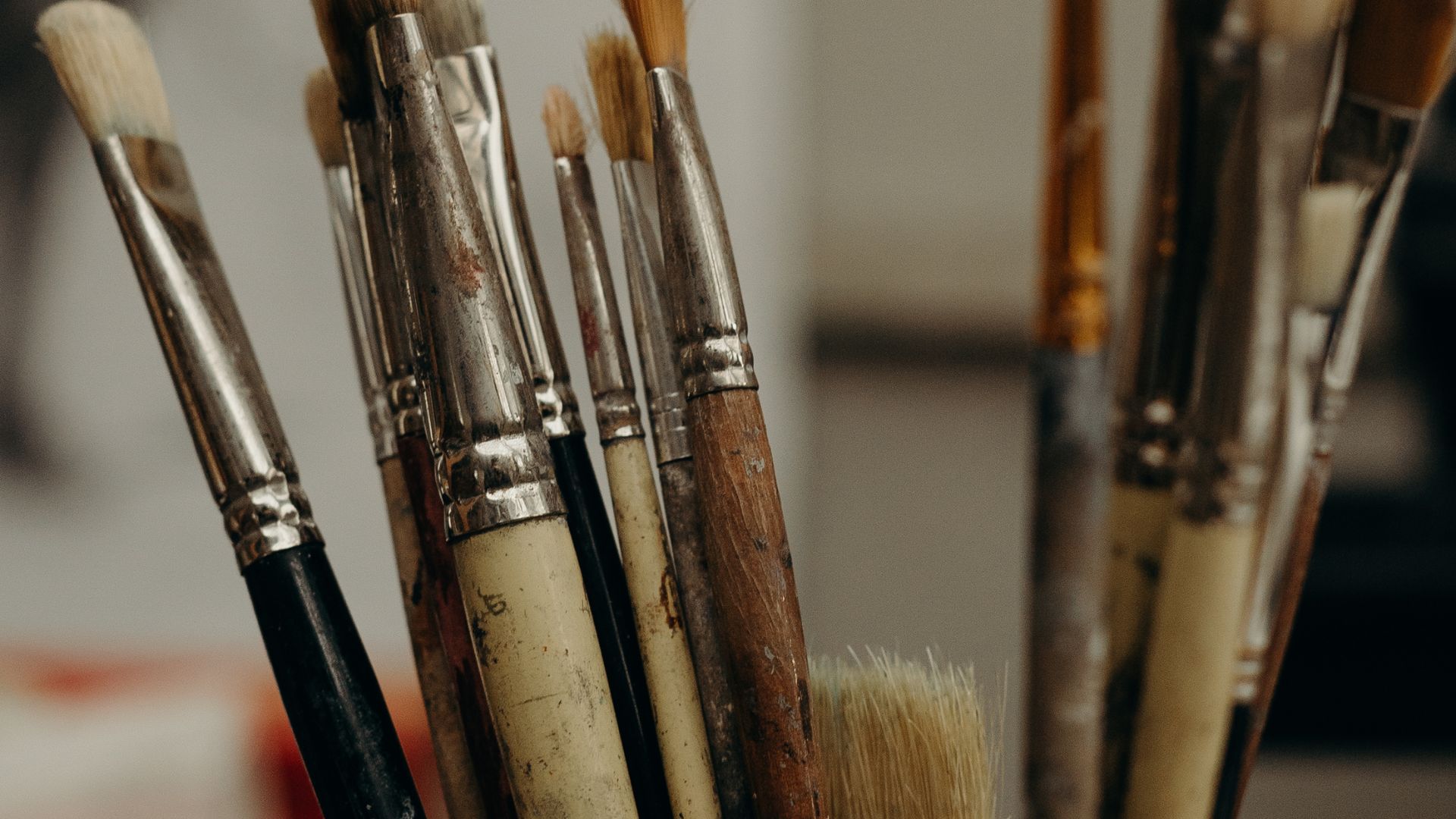When it comes to painting on canvas walls, selecting the right brush can significantly impact the outcome of your project. The type of brush you choose can influence the texture, precision, and overall finish of your work. Here’s a breakdown of the brushes you should consider for painting on canvas walls:
1. Brush Bristle Types
When selecting a brush for canvas wall painting, consider the bristle type:
- Synthetic Brushes: Ideal for water-based paints like acrylics. They offer flexibility, durability, and are easier to clean.
- Natural Bristle Brushes: Perfect for oil-based paints. They hold more paint and create a smoother finish, but they can be more challenging to clean.
2. Brush Shapes and Sizes
The shape and size of the brush determine the strokes and coverage:
- Flat Brushes: Great for broad strokes and filling in larger areas efficiently.
- Round Brushes: Ideal for detail work and creating intricate designs or lines.
- Angled Brushes: Perfect for reaching corners and edges with precision.
3. Consider the Canvas Size
The size of the canvas wall matters when choosing a brush:
- Large Brushes: Suitable for covering larger areas quickly, ideal for bigger canvas walls.
- Medium to Small Brushes: Perfect for detailed work and smaller canvas sections.
Tips for Selecting the Right Brush:
- Consider the Paint Type: Match the brush type to the paint you’re using.
- Test Before Painting: Experiment with different brushes on a small section of the canvas to see how they perform.
- Invest in Quality Brushes: Higher-quality brushes tend to last longer and provide better results.
- Maintenance Matters: Clean your brushes properly after each use to maintain their quality and longevity.

Calm male artist painting on canvas using paintbrushes
External Resources for Brush Selection:
- The Spruce Crafts – Types of Paintbrushes: This guide explains different paintbrush types and their uses.
- Art is Fun – How to Choose the Right Paintbrush: Offers insights into selecting brushes based on painting techniques.
- Blick Art Materials – Brush Buying Guide: A comprehensive guide to choosing brushes based on mediums and surfaces.
Selecting the right brush for painting on canvas walls involves considering the paint type, canvas size, and desired finish. Experimentation and understanding the characteristics of different brushes will help you achieve the desired results. Remember, the perfect brush ultimately depends on your personal preference and the specific requirements of your painting project.
Let’s dive deeper into the nuances of choosing the ideal brush for painting on canvas walls:
Understanding Brush Materials
- Nylon Brushes: These are versatile and work well with water-based paints like acrylics. They’re durable and maintain their shape, making them suitable for canvas walls.
- Polyester Brushes: Similar to nylon, they are durable and easy to clean, making them great for acrylic paints on canvas walls.
- Hog Bristle Brushes: Ideal for oil-based paints, hog bristle brushes hold more paint and are robust, making them suitable for canvas surfaces.
Matching Brushes to Painting Techniques
- Blending and Softening: For techniques involving blending and softening colors, consider using softer bristle brushes or fan brushes to achieve seamless transitions.
- Texture Creation: Stiffer bristle brushes or brushes with irregular shapes can help create textures and add depth to your canvas wall painting.
Consider the Handle and Grip
- Long Handle Brushes: These are suitable for standing back and painting larger areas, giving you more reach and control over your strokes.
- Short Handle Brushes: Perfect for closer, detailed work and when you need more precision and control.
Maintaining Your Brushes
- Cleanliness is Key: Rinse brushes thoroughly after each use to prevent paint buildup, which can ruin the bristles.
- Storage Matters: Store your brushes properly, keeping them in a dry, upright position or hanging to maintain their shape.
Experimentation and Personal Preference
- Try Different Brushes: Don’t hesitate to experiment with various brushes to understand how each one handles paint and interacts with your canvas wall.
- Comfort and Feel: Your comfort while using a brush matters. Some artists prefer specific handles or shapes that feel more natural in their hands.
Selecting the right brush for painting on canvas walls involves a combination of understanding brush types, considering the painting technique, and personal preference. The diverse range of brushes available allows artists to explore and find the perfect tools for their specific projects.
Let’s explore some additional aspects and considerations when it comes to choosing brushes for painting on canvas walls:
Specialized Brushes for Specific Effects
- Sponge Brushes: These are great for creating textured effects or applying paint in a stippling motion, adding depth and dimension to your canvas walls.
- Detailing Brushes: Fine-tipped brushes allow for intricate detailing and precise lines, perfect for adding intricate elements or small accents to your painting.
Quality Over Quantity
Investing in a few high-quality brushes is often more beneficial than having a large collection of lower-quality ones. Quality brushes tend to hold their shape better, provide better control, and last longer with proper care.
Cleaning and Maintenance Tips
- Immediate Cleaning: Try to clean your brushes as soon as you’re done painting to prevent the paint from drying and damaging the bristles.
- Gentle Cleaning: Use mild soap and water for synthetic brushes, and for natural brushes, use appropriate cleaning agents suitable for the paint type (such as linseed oil for oil-based paints).
- Reshaping Brushes: After cleaning, gently reshape the bristles and allow them to air dry thoroughly before storing them.
Knowing When to Replace Brushes
Even with proper care, brushes wear out over time. Signs that indicate it’s time for a replacement include splayed or frayed bristles, loss of shape, or difficulty in achieving desired strokes.
Testing Your Brushes
Before starting your canvas wall painting, perform a quick test with the chosen brushes on a scrap piece of canvas or a small area of the wall. This helps understand how the brushes interact with the paint and surface, ensuring you achieve the desired effects.
Finding Inspiration and Guidance
- Online Tutorials and Resources: Explore online tutorials, videos, or forums where artists share their experiences and recommendations for painting on canvas walls.
- Local Art Stores and Workshops: Visit local art stores or attend workshops where experts can provide guidance on brush selection and usage.
Conclusion
The right brush can elevate your canvas wall painting, making it a rewarding and enjoyable experience. By understanding the different brush types, experimenting with various options, and caring for your brushes, you’ll be well-equipped to create stunning artworks on your canvas walls.
Remember, while guidance is beneficial, the joy of painting often lies in exploration and discovering techniques that suit your unique style and preferences. Enjoy the journey of painting on canvas walls, and let your creativity flow through your choice of brushes and artistic expression.
Comparison tabular on this
| Aspect | Synthetic Brushes | Natural Bristle Brushes |
|---|---|---|
| Ideal for Paint Type | Acrylics, water-based paints | Oils, oil-based paints |
| Durability | Durable, maintain shape | More prone to wear, but hold more paint and create smoother finish |
| Ease of Cleaning | Easier to clean | Require specific cleaning agents for oil-based paints |
| Texture Creation | Suitable for textures with proper technique | Great for smooth finishes and blending |
| Detail Work | Can handle detailed work | Good for general coverage and larger strokes |
| Handle Length | Available in various handle lengths | Generally come with longer handles for broader strokes |
| Recommended Use | Versatile, suitable for beginners and various techniques | Preferred by experienced artists for specific effects |
| Maintenance | Rinsing with mild soap and water | Require specific cleaning agents and reshaping after use |
| Cost | Often more affordable | Higher cost due to the quality of bristles |
This table gives a quick comparison between synthetic and natural bristle brushes, highlighting their differences in terms of paint compatibility, durability, cleaning requirements, texture creation, and more. Remember, the choice between these brushes often depends on personal preference, the specific painting project, and the desired outcome.
Wrapping up
Choosing the right brush for painting on canvas walls is an essential step in ensuring your artistic vision comes to life. Whether you opt for synthetic brushes, perfect for water-based paints like acrylics and offering durability and versatility, or natural bristle brushes, favored for oil-based paints and their ability to create smoother finishes, your choice significantly impacts your artwork.
Consider factors like the paint type, desired texture, handle length, and maintenance requirements when selecting your brushes. Investing in quality brushes, maintaining them well, and experimenting with various types can enhance your painting experience and the quality of your finished piece.
Remember, there’s no one-size-fits-all approach. Embrace the joy of discovery, explore different brushes, techniques, and styles. Your creativity knows no bounds, and with the right brushes as your companions, your canvas walls can transform into stunning works of art. Happy painting!

For over a decade, I’ve been Mike, an artist, crafter, and designer deeply immersed in the Croc world. I thrive on crafting unique, size-inclusive patterns, fostering creativity, and sharing them on ktforum.com. My designs aim to ignite your creative spark and delight you, ensuring clarity and ease of use through rigorous testing. Join me in expressing your creative flair and showcasing your craft with joy.
Related Posts
- Choosing the Right Tools for Painting on Canvas
When it comes to painting on canvas, selecting the right tools can significantly impact your…
- Choosing the Right Canvas for Your Wall Paint
When it comes to transforming your walls into captivating artworks, selecting the right canvas is…
- Choosing the Right Paintbrush for Mural Painting
Painting a mural is an exciting and expressive way to transform a space, but selecting…
- Should You Sand a Canvas Before Painting it with Wall Paint
When it comes to using wall paint on canvas, the question of sanding often arises.…

